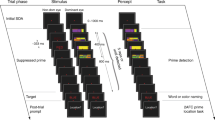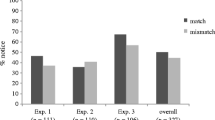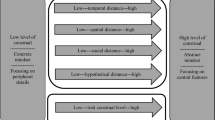Abstract
Unconscious thought refers to cognitive or affective decision-related processes that take place outside conscious awareness. Studies have found that activation of local processing in Navon small-letter tasks interferes with the global processing of information by unconscious thought, while activation of global processing by Navon large-letter tasks does not. Additionally, the color red activates local processing, while the color blue activates global processing. Therefore, this study examined whether the color red interferes with the global processing of information by unconscious thought and whether the color blue does not. The results of experiment 1 showed that, compared to participants in the red-background unconscious thought condition, participants in the blue-background unconscious thought condition were better able to discriminate between whether mobile phones were considered desirable or undesirable. The results of experiment 2 showed that participants in the red-background unconscious thought condition mainly depended on expectancy-congruent information (such as walking slowly) to evaluate elderly people, while participants in the blue-background unconscious thought condition used both expectancy-congruent and expectancy-incongruent information (such as walking quickly) for such evaluation. These results show that the color red activates local processing and interferes with the global processing of information by unconscious thought, while activation of global processing by the color blue does not produce interference.



Similar content being viewed by others
References
Abadie, M., Waroquier, L., & Terrier, P. (2013). Gist memory in the unconscious-thought effect. Psychological Science, 24, 1253–1259. https://doi.org/10.1177/0956797612470958.
Bos, M. W., & Dijksterhuis, A. (2011). Unconscious thought works bottom-up and conscious thought works top-down when forming an impression. Social Cognition, 29, 727–736. https://doi.org/10.1521/soco.2011.29.6.727.
Creswell, J. D., Bursley, J. K., & Satpute, A. B. (2013). Reactivation links unconscious thought to decision making performance. Social Cognitive and Affective Neuroscience, 8, 863–869.
Dijksterhuis, A. (2004). Think different: The merits of unconscious thought in preference development and decision making. Journal of Personality and Social Psychology, 87, 586–598. https://doi.org/10.1037/0022-3514.87.5.586.
Dijksterhuis, A., & Meurs, T. (2006). Where creativity resides: The generative power of unconscious thought. Consciousness and Cognition, 15, 135–146. https://doi.org/10.1016/j.concog.2005.04.007.
Dijksterhuis, A., & Nordgren, L. F. (2006). A theory of unconscious thought. Perspectives on Psychological Science, 1, 95–109. https://doi.org/10.1111/j.1745-6916.2006.00007.x.
Dijksterhuis, A., & Strick, M. (2016). A case for thinking without consciousness. Perspectives on Psychological Science, 11, 117–132. https://doi.org/10.1177/1745691615615317.
Dijksterhuis, A., & van Knippenberg, A. (1995). Memory for expectancy-consistent and expectancy-inconsistent information as a function of processing pace. European Journal of Social Psychology, 25, 689–694. https://doi.org/10.1002/ejsp.2420250607.
Dijksterhuis, A., Bos, M. W., Nordgren, L. F., & van Baaren, R. B. (2006). On making the right choice: The deliberation-without-attention effect. Science, 31, 1005–1007. https://doi.org/10.1126/science.1121629.
Elliot, A. J. (2015). Color and psychological functioning: A review of theoretical and empirical work. Frontiers in Psychology, 6, 368. https://doi.org/10.3389/fpsyg.2015.00368.
Elliot, A. J., Maier, M. A., Binser, M. J., Friedman, R. S., & Pekrun, R. (2009). The effect of red on avoidance behavior in achievement contexts. Personality and Social Psychology Bulletin, 35, 365–375. https://doi.org/10.1177/0146167208328330.
Elliot, A. J., Andrew, J., Markus, A., & Maier, M. A. (2014). Color psychology: Effects of perceiving color on psychological functioning in humans. Annual Review of Psychology, 65, 95–120. https://doi.org/10.1146/annurev-psych-010213-115035.
Evans, J. (2008). Dual-processing accounts of reasoning, judgement. and social condition. Annual Review of Psychology, 59, 255–278. https://doi.org/10.1146/annurev.psych.59.103006.093629.
Förster, J. (2012). GLOMOsys: How and why of global and local processing. Current Directions in Psychological Science, 21, 15–19. https://doi.org/10.1177/0963721411429454.
Francis, G. (2013). Publication bias in “red, rank, and romance in women viewing men” by Elliot et al. (2010). Journal of Experimental Psychology General, 142, 292–296. https://doi.org/10.1037/a0027923.
Hasford, J. (2014). Should I think carefully or sleep on it? Investigating the moderating role of attribute learning. Journal of Experimental Social Psychology, 51, 51–55. https://doi.org/10.1016/j.jesp.2013.11.004.
Jonides, J., Schumacher, E. H., Smith, E. E., Lauber, E. J., Awh, E., Minoshima, S., et al. (1997). Verbal working memory load affects regional brain activation as measured by PET. Journal of Cognitive Neuroscience, 9, 462–475. https://doi.org/10.1162/jocn.1997.9.4.462.
Kuschel, S., Förster, J., & Denzler, M. (2010). Going beyond information given: How approach versus avoidance cues influence access to higher-order information. Social Psychological and Personality Science, 1, 4–11. https://doi.org/10.1177/1948550609345023.
Lassiter, G. D., Lindberg, M. J., González-Vallejo, C., Bellezza, F. S., & Phillips, N. D. (2009). The deliberation-without-attention effect: Evidence for an artifactual interpretation. Psychological Science, 20, 671–675. https://doi.org/10.1111/j.1467-9280.2009.02347.x.
Lerouge, D. (2009). Evaluating the benefits of distraction on product evaluations: The mindset effect. Journal of Consumer Research, 36, 367–379. https://doi.org/10.1086/599047.
Li, J. S., Gao, Q. Y., Zhou, J. F., Li, X. Y., Zhang, M., & Shen, M. W. (2014a). Bias or equality: Unconscious thought equally integrates temporally scattered information. Consciousness and Cognition, 25, 77–87. https://doi.org/10.1016/j.concog.2014.01.012.
Li, J. S., Zhu, Y. W., & Yang, Y. (2014b). The merits of unconscious thought in rule detection. PLoS One, 9, e106557. https://doi.org/10.1371/journal.pone.0106557.
Li, J. S., Wang, F., Shen, M. W., & Fan, G. (2017). The tendency of unconscious thought toward global processing style. Consciousness and Cognition, 53, 14–22. https://doi.org/10.1016/j.concog.2017.05.005.
Maier, M. A., Elliot, A. J., & Lichtenfeld, S. (2008). Mediation of the negative effect of red on intellectual performance. Personality and Social Psychology Bulletin, 34, 1530–1540. https://doi.org/10.1177/0146167208323104.
McMahon, K., Sparrow, B., Chatman, L., & Riddle, T. (2011). Driven to distraction: Impacts of distractor type and heuristic use in unconscious and conscious decision making. Social Cognition, 29, 683–698. https://doi.org/10.1521/soco.2011.29.6.683.
Mealor, A. D., & Dienes, Z. (2012). Conscious and unconscious thought in artificial grammar learning. Consciousness and Cognition, 21, 865–874. https://doi.org/10.1016/j.concog.2012.03.001.
Mehta, R., & Zhu, R. (2009). Blue or red? Exploring the effect of color on cognitive task performances. Science, 323, 1226–1229. https://doi.org/10.1126/science.1169144.
Navon, D. (1977). Forest before trees: The precedence of global features in visual perception. Cognitive Psychology, 9, 353–383. https://doi.org/10.1016/0010-0285(77)90012-3.
Nieuwenstein, M. R., Wierenga, T., Morey, R. D., Wicherts, J. M., Blom, T. N., Wagenmakers, E. J., et al. (2015). On making the right choice: A meta-analysis and large-scale replication attempt of the unconscious thought advantage. Judgment & Decision Making, 10, 1–17.
Smeesters, D., & Liu, J. E. (2011). The effect of color (red versus blue) on assimilation versus contrast in prime-to-behavior effects. Journal of Experimental Social Psychology, 47, 653–656. https://doi.org/10.1016/j.jesp.2011.02.010.
Strick, M., Dijksterhuis, A., Bos, M. W., Sjoerdma, A., van Baaren, R. B., & Nordgren, L. F. (2011). A meta-analysis on unconscious thought effects. Social Cognition, 29, 738–762. https://doi.org/10.1521/soco.2011.29.6.738.
Watson, D., Clark, L. A., & Tellegen, A. (1988). Development and validation of brief measures of positive and negative affect: The PANAS scales. Journal of Personality and Social Psychology, 54, 1063–1107. https://doi.org/10.1037/0022-3514.54.6.1063.
Yang, H., Chattopadhyay, A., Zhang, K., & Dahl, D. W. (2012). Unconscious creativity: When can unconscious thought outperform conscious thought? Journal of Consumer Psychology, 22, 573–581. https://doi.org/10.1016/j.jcps.2012.04.002.
Acknowledgments
This research is supported by the National Natural Science Foundation of China (31560281), the Gansu Provincial Social Science Foundation (YB027), and the Gansu Education Science Planning Project (GS[2018]GHBW002).
Author information
Authors and Affiliations
Corresponding author
Ethics declarations
Conflict of Interest
Authors declares that they have no conflict of interest.
Ethical Approval
The Study Was Conducted after Obtaining Institutional Review Board Approval from the Department of Psychology at Northwest Normal University. We Received the Written Consent of all Participants before Testing Began. All Procedures Performed in Studies Involving Human Participants Were in Accordance with the Ethical Standards of the Institutional and/or National Research Committee and with the 1964 Helsinki Declaration and its Later Amendments or Comparable Ethical Standards
Informed Consent
Informed consent was obtained from all individual participants included in the study.
Additional information
Publisher’s Note
Springer Nature remains neutral with regard to jurisdictional claims in published maps and institutional affiliations.
Appendix 1 Mobile phone attributes
Appendix 1 Mobile phone attributes
More or fewer pre-installed games
Large or small display screens
Convenient or inconvenient to carry
Strong or weak GPS function
Convenient or inconvenient maintenance
High or low camera pixel
Long or short after-sales service period
Large or small memory
More or fewer supports for audio and video file formats
Fast or slow Internet connection
Convenient or inconvenient handwriting input
Good or poor Mp3 sound quality
Rights and permissions
About this article
Cite this article
Li, J., Chen, L., Pan, D. et al. Red or blue? Effects of background color in distraction tasks on global processing in unconscious thought. Curr Psychol 40, 2153–2160 (2021). https://doi.org/10.1007/s12144-019-0154-2
Published:
Issue Date:
DOI: https://doi.org/10.1007/s12144-019-0154-2




